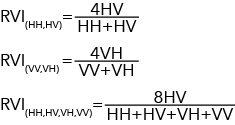| Label | Explanation | Data Type |
Input Radar Data
| The input radar data. | Raster Dataset; Raster Layer |
Output Raster
| The output SAR index raster. | Raster Dataset |
Index
(Optional) | Specifies the SAR index that will be computed.
| String |
Polarization Bands
(Optional) | Specifies the polarization bands that will be used in the index computation. This parameter is only supported when the Input Radar Data parameter value is a quad-polarized SAR dataset and the Index parameter value is Radar Vegetation Index (RVI) or Radar Forest Degradation Index (RFDI).
| String |
Available with Image Analyst license.
Summary
Computes various SAR indices for synthetic aperture radar (SAR) data, such as Radar Vegetation Index (RVI), Radar Forest Degradation Index (RFDI), and Canopy Structure Index (CSI).
The formulas used for these indices depend on the polarizations available in the input radar dataset.
Usage
The input radar data must be in linear units. If the data is in decibels (dB), use the Convert SAR Units tool to convert the radar data to linear units.
For input SAR data that is quad-polarized, the tool will provide the three possible formula options for the RVI index. RVI requires HH, HV; VV, VH; or HH, HV, VH, VV polarizations.

The tool will provide two possible options for the RFDI index. RFDI requires HH, HV or VV, VH polarizations.

The tool will provide one option for the CSI index. CSI requires HH, VV polarizations.

For RFDI and RVI, cities, deserts, and water bodies can have values corresponding to barren, degraded, and deforested landscapes, since little or no vegetation is inherent to those regions. Although most values will fall within the 0 to 1 range, there may be outliers resulting from double bounce or volume scattering.
Parameters
ComputeSARIndices(in_radar_data, out_raster, {index}, {polarization_bands})| Name | Explanation | Data Type |
in_radar_data | The input radar data. | Raster Dataset; Raster Layer |
out_raster | The output SAR index raster. | Raster Dataset |
index (Optional) | Specifies the SAR index that will be computed.
| String |
polarization_bands (Optional) | Specifies the polarization bands that will be used in the index computation. This parameter is only supported when the in_radar_data parameter value is a quad-polarized SAR dataset and the index parameter value is RVI or RFDI.
| String |
Code sample
This example computes RVI from a quad-polarized SAR dataset.
import arcpy
arcpy.env.workspace = r"C:\Data\SAR"
out = arcpy.ia.ComputeSARIndices(
"Quad-Polarization_manifest_CalB0_TNR_RTFG0_Dspk_GTC.crf", "RVI",
"HH, HV, VH, VV")
out.save("Quad-Polarization_manifest_CalB0_TNR_RTFG0_Dspk_GTC_RVI.crf")This example computes RVI from a quad-polarized SAR dataset.
# Import system modules and check out ArcGIS Image Analyst extension license
import arcpy
arcpy.CheckOutExtension("ImageAnalyst")
from arcpy.ia import *
# Set local variables
arcpy.env.workspace = r"C:\Data\SAR"
in_radar_data = "Quad-Polarization_manifest_CalB0_TNR_RTFG0_Dspk_GTC.crf"
out_raster = "Quad-Polarization_manifest_CalB0_TNR_RTFG0_Dspk_GTC_RVI.crf"
index = "RVI"
polarization_bands = "HH, HV, VH, VV"
# Execute
out = arcpy.ia.ComputeSARIndices(
in_radar_data, out_raster, index, polarization_bands)
out.save(out_raster)